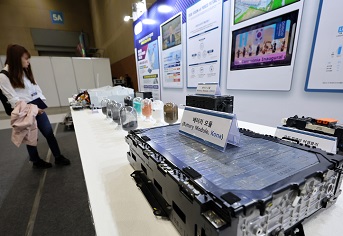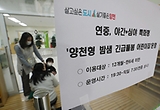Mr. Scott Snyder,
Distinguished Participants,
Ladies and Gentlemen,
I am delighted to be here with you, the leading academics and experts on the Korea issues in the U.S., to discuss the Northeast Asia Peace and Cooperation Initiative (NAPCI) which is one of the main pillars of the foreign policy of the Park Geun-hye Government. I thank the Council on Foreign Relations and the Asan Institute for Policy Studies for jointly organizing this important meeting.
Today’s meeting has special significance as it is hosted by the Council on Foreign Relations, a world renowned think tank inaugurated in the wake of World War I inspired by Woodrow Wilson's internationalism. Over the past century, the Council has indeed played a critical role in every historic moment when the world witnessed a major paradigm shift in international relations.
I hope and expect that we will benefit from your insight and wisdom in the pursuit of our goal envisioned by the initiative; that is, building a structure of endurable peace and trust in Northeast Asia where a dramatic change in the political landscape is now taking place.
Political Situation in Northeast Asia and NAPCI
Distinguished Participants,
Today, Northeast Asia is transforming into an arena of competition for 'offensive realism', a concept introduced by Professor John Mearsheimer. The showdown rages on among countries in the region driven by self-interests.
The source of tension in the East China Sea has yet to be resolved, while regional conflict arising from Japan’s historical revisionism is continuing to increase.
The Gordian knot has yet to be untied also on the Korean Peninsula. North Korea, which has been posing a serious threat to regional security with its nuclear tests, is still engaging in a series of provocations. Since last February, North Korea has fired over 270 rockets and missiles.
We believe that the source of such tension and conflict lies in a deficit of trust. The lack of mutual trust is leading to a security dilemma in Northeast Asia. We are witnessing a vicious cycle of conflict among countries in the region mistrusting each other and, in turn, pursuing self-seeking actions.
Shaping a bright future of cooperation and harmony is impossible unless an infrastructure of trust is built in the region. It is for this reason that the Park Geun-hye Government has been pursuing NAPCI, an initiative to transform the culture of mistrust and confrontation in the region into that of reconciliation and cooperation by accumulating practices and habits of dialogue and cooperation in the areas where cooperation is relatively easy and the burden of participation is less.
Answers to Key Questions on NAPCI
As the basic concept and approaches of NAPCI will be further elaborated by the Korean experts at the sessions to follow, I would like to lead off the discussions by sharing my thoughts on the key questions that were raised on the initiative on previous occasions such as this one held in Korea and abroad.
The first and most frequently asked question on NAPCI was, “How does it differ from the Northeast Asian initiatives of Korea’s previous administrations?”
In a nutshell, previous initiatives resorted to a top-down approach based on political agreements among leaders, rather than building trust by pursuing concrete cooperation projects. Therefore, they were never implemented in full. Some focused on traditional security issues, while others sought to establish a regional security and economic community. It proved to be difficult to achieve tangible outcomes as they were too broad in concept and too grand in scale.
NAPCI, on the other hand, focuses on harnessing high-level political will, while accumulating practices and habits of dialogue and cooperation on small but important, non-traditional, soft security issues. In other words, it takes a more realistic and practical approach that pursues a top-down momentum based on a bottom-up process.
As a corollary, NAPCI is an evolving and process-oriented policy. Rather than aiming to make tangible progress in a short span of time, the initiative will be pursued at a speed that all stakeholders can be comfortable with. As for the level of cooperation, flexibility will be exercised so that all interested countries can voluntarily participate in, and due consideration will be given to the level of trust among the participating countries. All of them will be invited to work together as co-architects who can also take the lead in the area of their interest or priority.
Another question frequently and implicitly asked on NAPCI was, “Isn’t Korea pursuing the initiative with the intention of setting up a new organization with its ownership?”
I want to make it clear that aside from pursuing a multilateral process of security cooperation in the region, we do not have any other strategic calculation in mind. NAPCI has been formulated based on the experiences and lessons learned from our previous regional initiatives and with a focus on the achievability of its desired goals. We have no illusion that an organization will be set up simply because we plan for it to happen. Nor are we so naïve as to create obstacles to realizing the initiative by inciting unnecessary suspicions.
The third question commonly raised was, “Is NAPCI primarily aimed at resolving the North Korean issue including its nuclear program?”
Of course, NAPCI and the Trust-Building Process on the Korean Peninsula will lead and complement each other in a mutually reinforcing way. And if cooperation and trust is promoted in Northeast Asia, we can expect it to have a positive impact on the denuclearization process on the Korean Peninsula. However, NAPCI is not an initiative aiming to resolve the North Korean nuclear issue per se or to replace the on-going Six Party Talks.
The fourth question which is also related to the previous one was, “What to do with North Korea?” More specifically, “Is it not a ‘6 minus 1’ structure that excludes North Korea?”
We absolutely have no intention of excluding North Korea. Rather, we will continue to engage North Korea from the early stages of cooperation on any issue. We will leave the door open for North Korea to participate in the whole process, including in whatever area of its interest and at any time of its own choice. In this regard, we are going to invite North Korea to participate in the international forum on NAPCI scheduled to be held in Seoul later this month.
The next commonly asked question was, “What is the added value that the initiative will create?”
It is true that regional and international mechanisms of cooperation already exist in many areas and are readily available for use in the Northeast Asian context as well. Trilateral Cooperation Secretariat or TCS created by China, Japan and Korea is a good example and is still evolving. However, virtually all existing cooperative mechanisms in Northeast Asia are focused on technical and functional cooperation, rather than looking at the issues with a broader perspective of regional peace and security. NAPCI aims to add a security dimension to the regional cooperation mechanisms by linking the existing mechanisms within the larger framework of the initiative and, if necessary and available, by creating new processes of dialogue and cooperation on a set of selected soft security areas.
The sixth question was, “How can you make the cooperation process on soft issues develop into a multilateral security mechanism in the region?”
In order for any multilateral cooperation projects on soft security issues to remain sustainable in Northeast Asia, they need to be pursued with a discreet strategy to establish a direct or indirect link with traditional security issues. This is why NAPCI aims to complement the regional security perspectives, while addressing soft issues. And through this, it aims to preclude a disconnected approach between soft and hard security issues. Of course, to make it possible, the political leadership of all countries in the region will be necessary and critical.
The seventh and final question was, “Would it be possible to realize NAPCI given the worsening relations of Japan with Korea and China, respectively?”
The current state of relations among the three countries in the region could naturally and automatically invite such questions. However, the cooperation among China, Japan and Korea has been rapidly growing across a wide range of areas, regardless of political ups and downs. And because such a momentum of cooperation is created out of need, I do not believe it will easily disappear.
Paradoxically, the deteriorating political relations dictate us to act with a greater sense of urgency to seek ways to rebuild trust. We should take heed of the lessons of CSCE/OSCE, which contributed to building peace in Europe at a time when the region was divided with serious confrontation and mistrust.
Progress and Future Action Plans to Implement NAPCI
Since its inauguration in February last year, the Park Geun-hye Government has been actively pursuing the implementation of NAPCI and some meaningful progresses have been made.
We have fully utilized the summit meetings and high-level dialogues to share our vision and goals in pursuing this initiative, while actively conducting outreach activities similar to this meeting today. As a result, we have been able to receive wide support and understanding from countries around the world.
Based on this support, Korea has been working on concrete cooperation projects in the areas of nuclear safety, energy security, environmental protection, climate change, disaster relief and drug trafficking, among others.
In particular, in her National Liberation Day speech on August 15, President Park proposed to create a nuclear safety consultative mechanism in Northeast Asia, as Europe did for the creation of the European Coal and Steel Community (ECSC) and the European Atomic Energy Community (EURATOM).
Follow-up actions on this proposal were taken in September in the form of extended consultative mechanism of Top Regulators’ Meeting or TRM existing in Northeast Asia. We refer to this newly created mechanism as TRM Plus where in addition to the original members -- China, Japan, and Korea -- the U.S. and Russia are also participating. We will continue to upgrade the level of participation as well as broaden the scope of cooperation on nuclear safety of the region with a view to embracing its security implications.
Since the beginning of the second half of this year, we have also been holding a series of international events in order to raise international awareness of and support for the initiative. Last July, we successfully held a seminar with one of Europe's leading think tanks, Stockholm International Peace Research Institute (SIPRI), and held an in-depth discussion on Europe’s experience on multilateral security cooperation. In September, we held a joint seminar with the EU, which provided the opportunity to lay the academic groundwork to apply Europe's experiences in Northeast Asia.
As I introduced earlier, later this month, we plan to hold the Northeast Asia Peace and Cooperation Forum in Seoul, which will be the largest event on the initiative to date. High-level officials from countries in the region and experts from the private sector including think tanks will be invited to the event. By holding this forum, which includes track I and track II processes, we hope to create the right political momentum to pursue the initiative in full-scale.
Importance of the U.S. Support and Participation
Distinguished Participants,
History illustrates that the United States has been playing a critical role in promoting multilateral cooperation around the globe, which includes, among others, in the birth of the UN, NATO, and the OSCE, the multilateral security cooperation organization of Europe. Such a role of the United States in multilateral cooperation, together with its bilateral alliances, contributed to regional and global peace and stability, and reinforced the moral high ground the U.S. has maintained during and after the Cold War.
In my view, NAPCI is an initiative that will contribute to reinforcing the U.S. policy of 'Rebalancing to Asia'.
The success of NAPCI will contribute to reducing tension and building trust in the region, thereby creating the foundation to improve the bilateral relations between the major countries in the region. In particular, if the Korea-Japan relations can be steadily managed within the multilateral cooperation framework, it will certainly contribute to strengthening the trilateral security cooperation among Korea, the U.S. and Japan. As such, NAPCI not only serves but also reinforces the strategic interests of the U.S.
As I explained earlier, the main added value of NAPCI is to add the security dimension to the regional cooperation mechanism. Therefore, NAPCI cannot make tangible progress without the full support and active participation of the U.S. which plays a central role in maintaining peace and stability in Northeast Asia and beyond.
We hope that the U.S. will actively participate in all the processes and projects organized in pursuit of NAPCI and take the lead in the area of its interest, be it nuclear safety or health security. I mentioned earlier that one characteristic of the initiative is its openness: any country in the region is welcome to lead regional cooperation in a particular area of interest and, if appropriate, Korea is ready to play its role as a facilitator.
As you all know, Germany was able to secure peace and achieve eventual unification, while pushing for an alliance with NATO and multilateral security cooperation with CSCE. Korea wishes to follow the German example by pursuing a multilateral security cooperation that is based on the robust Korea-U.S. alliance.
Conclusion
Distinguished Participants,
In the aftermath of World War II, the international community held concerns that another round of armed conflict might break out with Germany and France as the two main axes. And at the time of creating the European Union, concerns were again voiced about its potential failure.
Today, however, the EU has become the most peaceful region in the world, and continues to maintain its strong solidarity. Even if a conflict arises among the EU countries, no one would anticipate this to lead into an armed conflict.
The seven decades of peace in Europe since World War II are the longest period of peace in the region since the birth of the nation-state in the 17th century. And it was trust accumulated by way of cooperation that led to the endurable peace in Europe.
"Things do not happen. Things are made to happen."
Just like this saying by President Kennedy, cooperation and trust building, and, in turn, peace, do not just happen. They will be realized when there is the will to make them happen.
NAPCI is an endeavor to collect such will and translate it into concrete actions. These actions will accumulate to create common benefits. And in the process of safeguarding such benefits, a long-term and sustainable peace will eventually take root in Northeast Asia.
Ultimately, commitment is what is important. We hope that as a balancer and stabilizer for the security in Northeast Asia, the U.S. will take part and lead in harnessing this commitment.
Thank you.
 이 누리집은 대한민국 공식 전자정부 누리집입니다.
이 누리집은 대한민국 공식 전자정부 누리집입니다.













